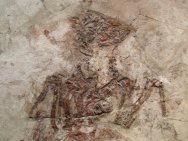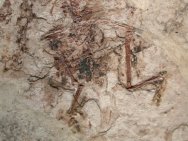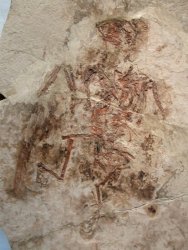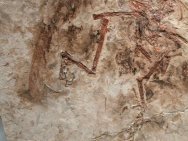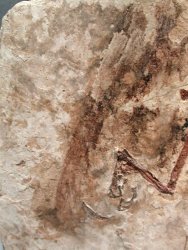Name: Eoentantiornis
buhleri (Cretaceous Fossil Bird - a dinosaur descendant) Phylum
Chordata, Subphylum Vertebrata, Class Aves, Subclass Enantiornithes,
Order Enantiornithiformes (Order went extinct along with the non-avian
dinosaurs)
Geological
Time: Late Cretaceous (~125 m.y.a.)
Size: 130
mm long (tip of skull to tip of toes), 68 mm across at wings. Matrix:
200 mm by 145 mm
Fossil
Site: Liaoning - Jiufotang Formation, Dapingfang, Chaoyang, Liaoning
Province of China
| 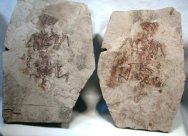 The
Enantiornithine birds at one time were
the
dominant group of birds during the Creatceous, only to go the way
of the dinosaurs by the end of the perioid. Their name is derived
in the meaning “opposite birds” due to a reverse articular
arrangement between the scapula and the coracoid from the typical
birds of today. Eoenantiornis (Hou, Zhou & Feduccia, 1999) is
one of the most primitive members of this subfamily; its name means
dawn opposite bird, signifying its primitive status The first specimens
found showed
a total of twelve teeth present in the distinctively short, triangular
skull. The
Enantiornithine birds at one time were
the
dominant group of birds during the Creatceous, only to go the way
of the dinosaurs by the end of the perioid. Their name is derived
in the meaning “opposite birds” due to a reverse articular
arrangement between the scapula and the coracoid from the typical
birds of today. Eoenantiornis (Hou, Zhou & Feduccia, 1999) is
one of the most primitive members of this subfamily; its name means
dawn opposite bird, signifying its primitive status The first specimens
found showed
a total of twelve teeth present in the distinctively short, triangular
skull.
Notice
the wings; the wing claws are visible, particularly the alular claws.
The alula (or “bastard wing”) is a feathered structure
which provides modern-day birds with additional
lift during slow flight. Neither Confuciusornis nor Archaeopteryx
had an alula, and so are thought to have been unable to take off
directly from ground level. Well-articulated specimens with feather
preservation are rarely offered. The wing feather preserved in good
detail here is fully 60 mm long, with other feathers evident as
a carbonized film. As is usually the case, the specimen did not
split exactly into a part/counterpart such that some bones are found
on either side, rather than bones to one side and impression on
the other.
|
|




